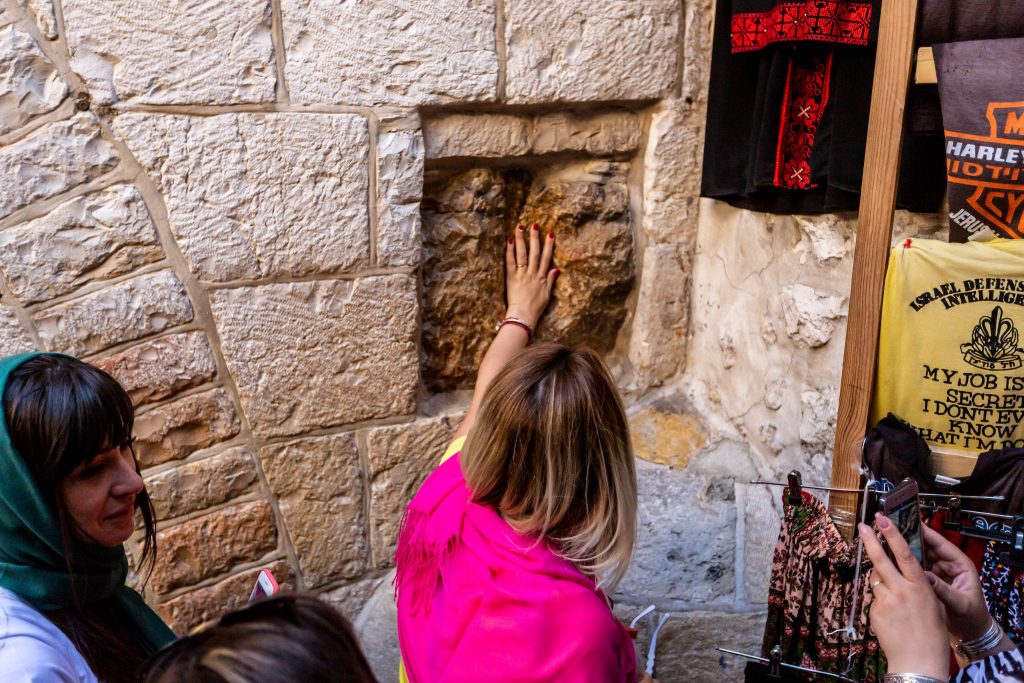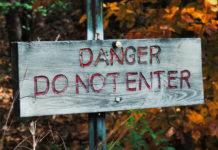The Via Dolorosa is a path through Jerusalem’s Old City that attempts to trace the journey Jesus might have taken on his way to the cross. At this stop, Station 5, it is believed that Simeon the Cyrene carried the cross for Jesus.

Here at Station 7 of the Via Dolorosa, it is believed that Jesus fell for the second time on His way to the cross.
Where Jesus Carried His Cross: Via Dolorosa
The road from Jesus’ trial to the place of His crucifixion is traditionally called Via Dolorosa, “Way of Suffering.” Scriptures give us only a couple of glimpses of what happened on this road. A large crowd of women followed Jesus, weeping as they went. A foreigner named Simon was tasked with carrying Jesus’ cross. It was truly a way of sorrow—Isaiah’s Suffering Servant was being stricken.
Today fourteen stations mark a defined route of the Via Dolorosa. Franciscan friars lead a weekly procession of pilgrims down the streets of old Jerusalem. Some of the stations commemorate events of tradition not recorded in Scripture, like a woman named Veronica wiping the face of Jesus. The authenticity of the entire route is also suspect. Even so, pilgrims find it meaningful to reflect on the passion of Christ as they walk through old Jerusalem toward Golgotha.
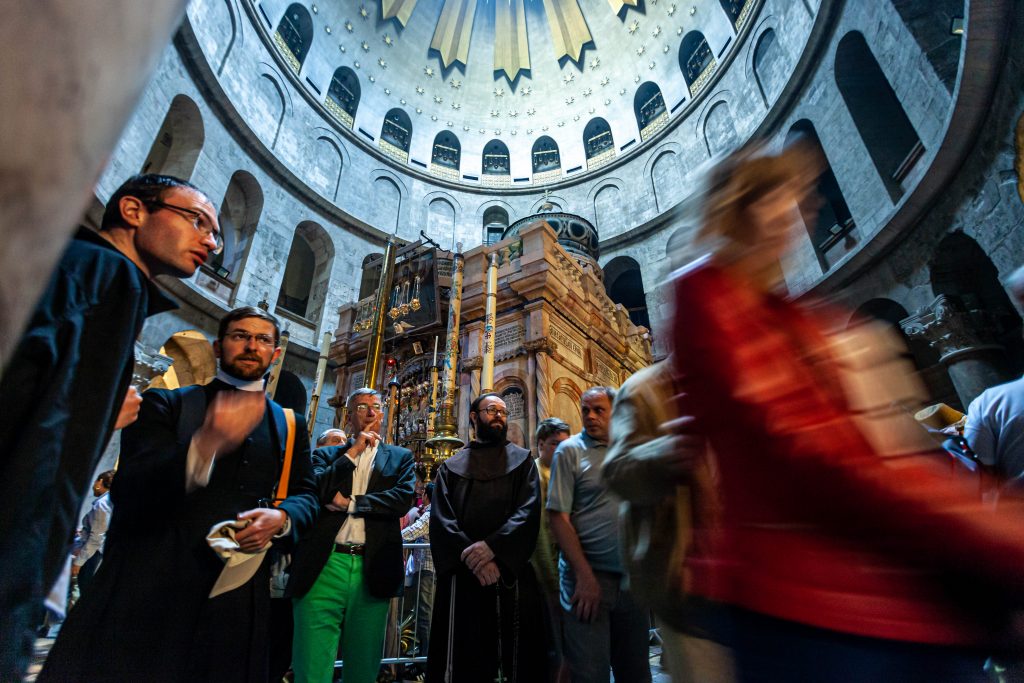
Church of the Holy Sepulchre in the Christian Quarter of Jerusalem’s Old City is centered on two main events—the site of Christ’s crucifixion and the site of Christ’s tomb. The word sepulchre means “tomb,” “catacomb,” or “crypt.” This smaller chapel inside the larger church dome is the place believed to be the tomb of Joseph of Arimathea where Christ was buried. Today pilgrims from around the world wait in a long line for the chance to briefly step into the chapel and view the temporary resting place of the Messiah.
Where Jesus Died: Church of the Holy Sepulchre
“And when they came to the place that is called The Skull, there they crucified him” (Luke 23:33). Here, Jesus took the punishment for sin. He suffered amid common criminals. The pain intensified as He slowly suffocated. He cried out in agony because of the broken relationship between Him and His heavenly Father. The Lamb of God went to the cross as a willing sacrifice to make atonement for all who believe in Him.
The Church of the Holy Sepulchre in Jerusalem is the location of Christ’s death and resurrection according to the vast majority of Christendom. Underneath the church, first-century tombs can still be seen. Once a rock quarry, the area became a cemetery and a place of executions after the stones were no longer usable. In the second century, the Roman Emperor Hadrian built a pagan place of worship over the site to deter its many Christian pilgrims. In the fourth century, Emperor Constantine’s mother, Helena, replaced it with a church. Significant portions of the current church remain from an eleventh-century Crusader church.
The church is a large space of sensory overload. Six Christian groups—Roman Catholic, Greek Orthodox, Armenian, Syrian, Coptic and Ethiopian—manage separate places of worship within the church. One of the most significant areas is the upper balcony, with the traditional site of Christ’s crucifixion and a stone from Golgotha under the Greek Orthodox altar. Equally notable is the Edicule on the lower level, which marks the traditional place of Jesus’ tomb.
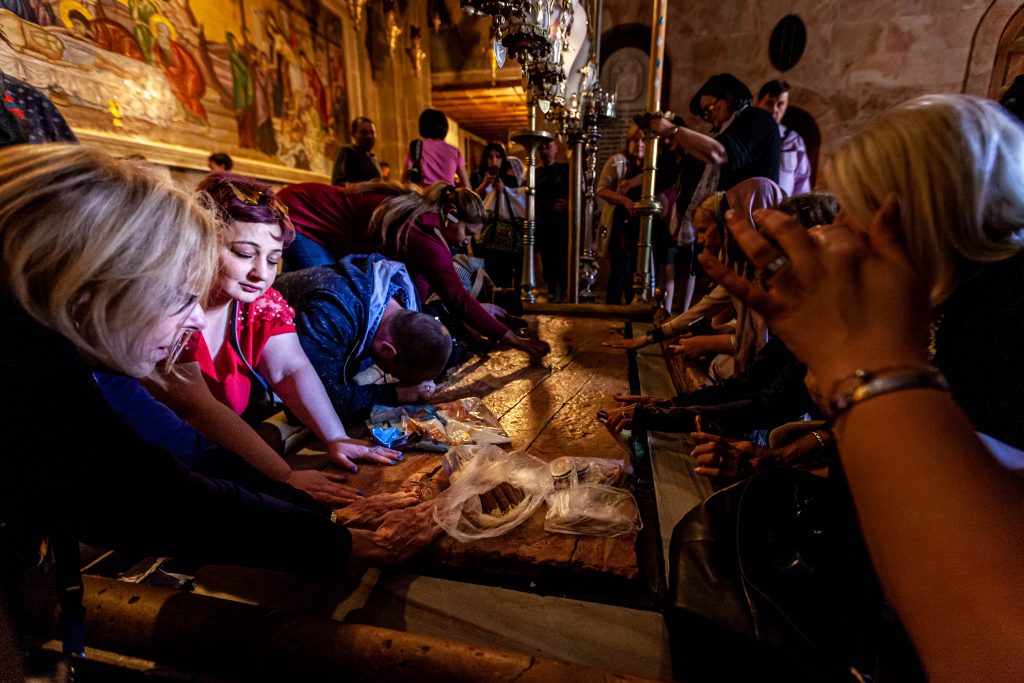
Pilgrims from around the world come to the Church of the Holy Sepulchre to worship and experience God. Here people touch and pray over the Stone of Anointing, a slab believed to be the place where Jesus’ body was laid after the crucifixion.
Visitors stream through the church from morning till night, many bringing religious articles and pieces of clothing for blessing. The Stone of Unction, also called the Stone of Anointing, is a stone said to be where Jesus was laid for anointing after His death. Even though its authenticity is questionable, the stone is meaningful to its many visitors who kiss it and pour and wipe oil with cloths brought from home.
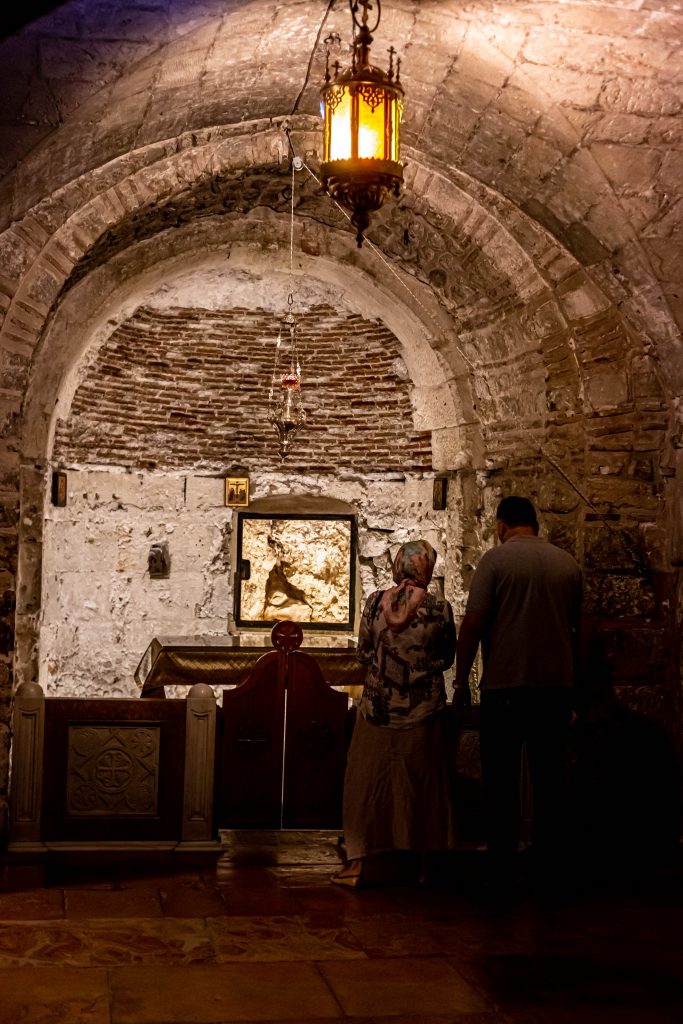
The lower level in the Church of the Sepulchre shows split rock from the first century. Some geologists believe this was a natural break in the rock, rendering it unusable for quarrying and subsequently offering the community a place for executions. Others, however, look at the rock and wonder, is this from the same earthquake that caused the centurion to exclaim in fear, “Truly this was the Son of God!” (Matt. 27:54). Jesus Himself said the very rocks would cry out (Luke 19:40).
Calvary Split and Atonement Accomplished
The Bible records several supernatural events at Jesus’ death. The curtain of the temple was torn in two from top to bottom, symbolizing the access we have into God’s presence because of Jesus’ death. Long-dead men and women of faith blinked open their eyes and walked out of their tombs. And an earthquake split rocks.
The lower level in the Church of the Sepulchre shows off split rock from the first century. Some geologists believe this was a natural break in the rock, rendering it unusable for quarrying and subsequently offering the community a place for executions. Others, however, look at the rock and wonder, is this from the same earthquake that caused the centurion to exclaim in fear, “Truly this was the Son of God!” (Matt. 27:54). After all, Jesus Himself said the very rocks would cry out (Luke 19:40).
All these signs, especially the greatest sign of all—Jesus’ own resurrection from the dead and ascension into heaven—testified to atonement accomplished. The humble man from Nazareth lived a perfect life and died as a sinless sacrifice for sin. He conquered death and appeared to many.
Jesus was a real man. But His life is not a past-tense life. He is a real man. And He is an eternal God who will come again to judge the world. When Jesus ascended into heaven on a cloud, two angels testified that He would come again in the same way He was taken (Acts 1:11).
As believers in Jesus Christ, let’s rejoice in Jesus’ life, earthly ministry, death and resurrection. He is not dead history. He is our living reality. Because of Christ, we can look to His example and endure suffering without despair. We can hope in our own bodily resurrection. And we can boldly share, by example and by word, that Jesus Christ is Lord. Just like the light that broke the darkness of that ancient Bethlehem field, the light and glory of God in the face of Jesus Christ brings hope to a hurting world. His glory is why we continue to go into the darkest places on earth with the message of salvation.
This article originally appeared here.


